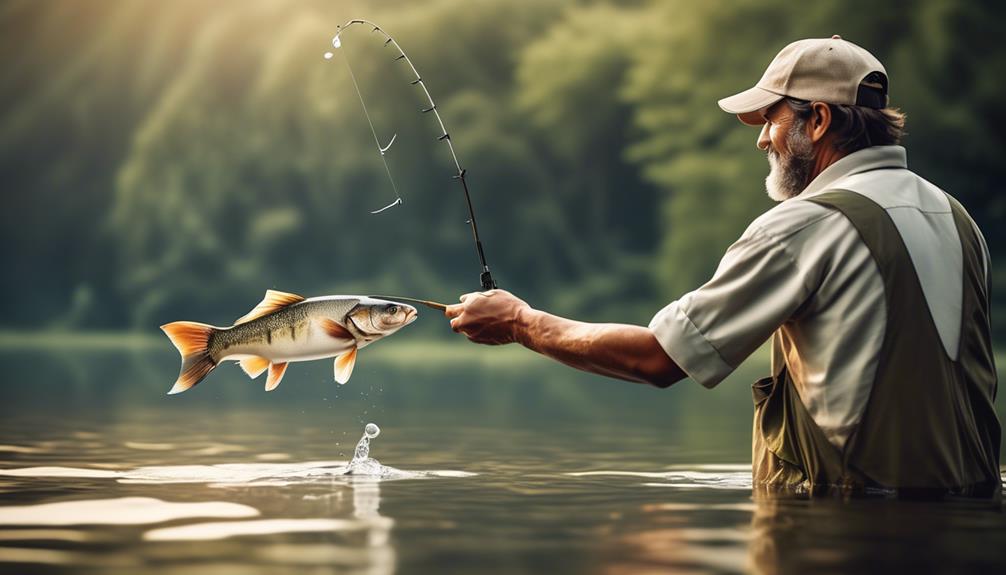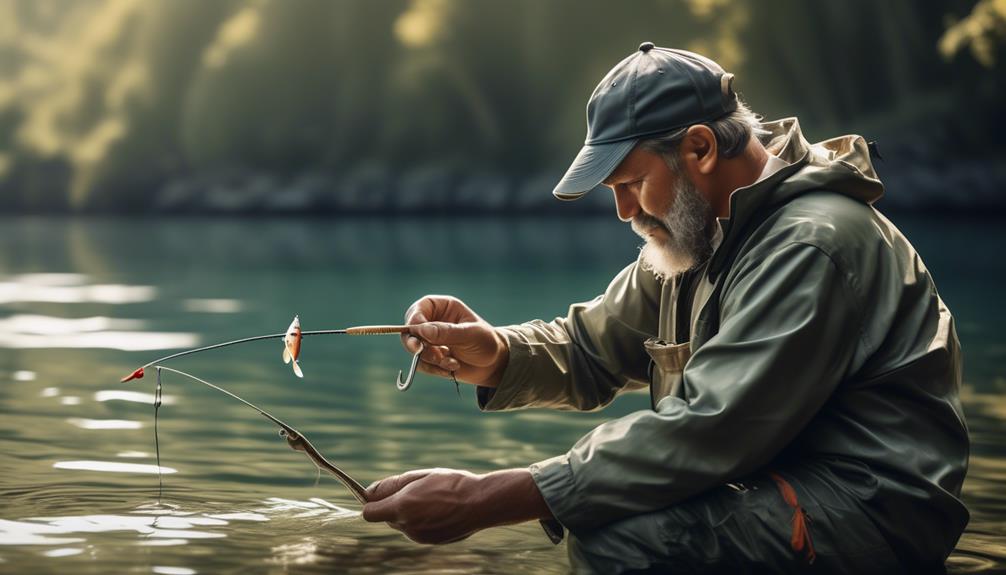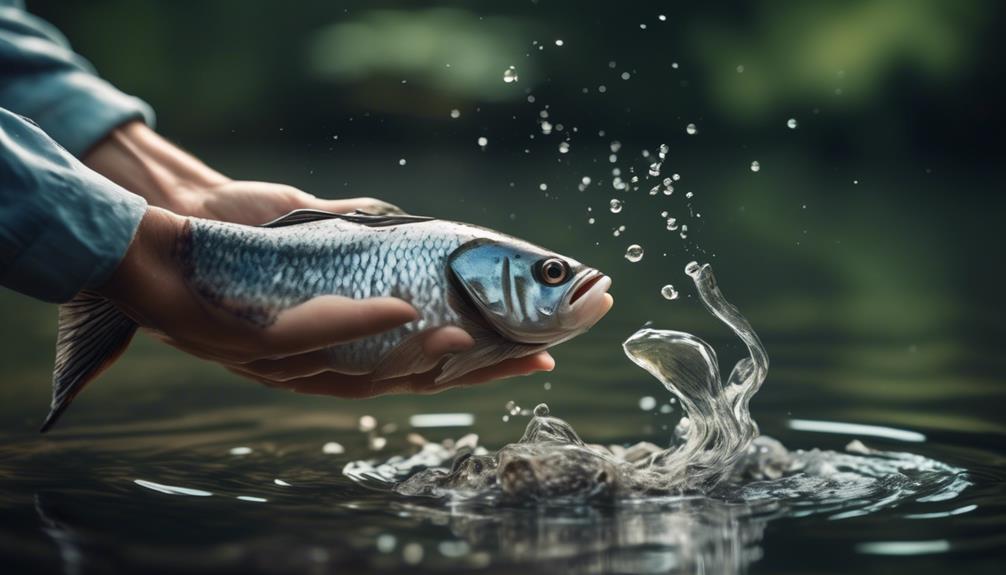Did you know that approximately 70% of recreational anglers practice catch and release fishing? This popular method of fishing has sparked a debate among anglers, conservationists, and scientists due to its potential impact on fish populations and ecosystems.
While catch and release is often seen as a sustainable approach, there are various factors to consider when evaluating its effectiveness and ethical implications. As you delve into the debate, you'll discover the complex considerations surrounding this widely practiced fishing technique and the ongoing discussions about its benefits and drawbacks.
Environmental Impact
The environmental impact of catch and release fishing can be significant, as it may lead to increased stress and mortality among fish populations. When fish are caught and released, they experience a level of habitat disturbance and ecosystem impact, disrupting their natural behaviors and potentially affecting their ability to survive. This disturbance can lead to physiological stress and decreased survival rates, especially if the fish are caught repeatedly or improperly handled during release.
Additionally, catch and release fishing can have consequences on genetic selection and population dynamics within fish species. Selective pressures imposed by catch and release fishing can affect the genetic diversity of fish populations, potentially leading to changes in their genetic composition over time. Furthermore, the increased mortality resulting from catch and release practices can impact population dynamics, potentially leading to declines in fish populations and disrupting the balance of ecosystems.
It's important for anglers to be mindful of the potential environmental impact of catch and release fishing and take measures to minimize harm to fish populations. This includes using proper gear and techniques to reduce stress and injury to the fish, as well as being aware of local regulations and guidelines for catch and release practices.
Fish Mortality Rates
Considering the potential environmental impact of catch and release fishing, anglers should be aware of the fish mortality rates associated with this practice. Research findings have shown that fish mortality rates can vary depending on various factors such as species, size, and handling techniques.
For example, some studies have indicated that certain species of fish, like bass and trout, have higher survival rates compared to others when released back into the water. Additionally, the size of the fish can also play a significant role in its survival post-release. Smaller fish tend to have higher survival rates than larger ones.
Furthermore, proper handling techniques and best practices can greatly influence the survival of fish after being caught and released. Anglers can minimize fish mortality rates by using barbless hooks, which cause less damage to the fish and make it easier to release them. Additionally, minimizing the time that the fish is out of the water, handling them with wet hands to protect their slime layer, and avoiding deep hooking can all contribute to higher survival rates for released fish.
Stress on Fish
To minimize stress on fish during catch and release, anglers should handle the fish carefully and efficiently. When catching a fish for release, it's important to consider the impact on the ecosystem and the ethical dilemma of causing unnecessary harm. Here are some tips to reduce stress on fish:
- Use barbless hooks: Barbless hooks are easier to remove, reducing the amount of time the fish is out of the water and minimizing injury.
- Keep the fish in the water: Minimize air exposure by unhooking the fish in the water, allowing it to swim away immediately.
- Avoid overplaying the fish: Reel in the fish as quickly as possible to reduce exhaustion and stress.
- Support the fish properly: When handling the fish, support its body to prevent damage to its organs and reduce the risk of injury.
The stress placed on fish during catch and release fishing can have a significant impact on the ecosystem. Stressed fish may struggle to survive after being released, leading to increased mortality rates and potential disruptions to the natural balance of aquatic environments.
Furthermore, the ethical dilemma arises from the responsibility of anglers to ensure that their fishing practices minimize harm to the fish and contribute to the sustainability of fish populations. By following proper catch and release techniques, anglers can help reduce the stress on fish and contribute to the conservation of aquatic ecosystems.
Effectiveness of Catch and Release
Minimizing the duration of the fight and handling the fish with care are crucial factors in determining the effectiveness of catch and release fishing. When you engage in catch and release, it's essential to understand fish behavior to increase the likelihood of their survival after being released back into the water. By reducing fight times, you can minimize the stress on the fish, which significantly impacts their ability to recover post-release. Additionally, proper handling techniques, such as using wet hands or a rubberized net, can prevent damage to the fish's skin and scales, further improving their chances of survival.
The effectiveness of catch and release also plays a significant role in population management. When done correctly, it can contribute to the conservation and sustainability of fish populations. By releasing fish back into their natural habitat, you allow them to continue their lifecycle, ultimately contributing to the overall health and abundance of the species. This practice becomes particularly important in areas where overfishing or declining populations are a concern.
Understanding the effectiveness of catch and release fishing isn't only about the immediate act of releasing a fish but also about the potential long-term impacts on fish populations. By considering factors such as fish behavior and population management, you can make informed decisions about catch and release practices, contributing to the conservation of fish species for future generations.
Angler Responsibility
When practicing catch and release fishing, it's your responsibility as an angler to ensure the proper handling and quick release of the fish to maximize their chances of survival. Angler education plays a crucial role in promoting responsible fishing practices. Here are some key points to remember:
- Proper Fish Handling: Always wet your hands before handling the fish to prevent damaging their protective slime layer. Avoid using towels or dry hands, as this can remove the slime coating, making the fish more susceptible to infections. Additionally, refrain from squeezing the fish tightly, as it can cause internal injuries.
- Use Barbless Hooks: Using barbless hooks can make the hook removal process quicker and less harmful to the fish. This reduces the handling time and stress for the fish, ultimately increasing its chances of survival after release.
- Minimize Air Exposure: Keep the fish in the water as much as possible. Limiting air exposure helps prevent stress and exhaustion, especially for larger fish, which may struggle to recover if out of the water for extended periods.
- Reviving the Fish: If the fish shows signs of exhaustion, hold it upright underwater, allowing it to regain its strength before swimming away on its own.
Ethical Considerations
Considering the impact of your actions on the environment and the well-being of the fish is essential when engaging in catch and release fishing. When practicing catch and release, it's crucial to prioritize animal welfare and conservation ethics. While the intention of catch and release is to minimize harm to fish populations, it's important to understand that the process can still cause stress and potential harm to the fish. Therefore, it's essential to handle the fish with care and release them properly to ensure their survival.
Animal welfare is a central ethical consideration in catch and release fishing. The well-being of the fish should be a top priority, and anglers should aim to minimize any potential harm or stress inflicted during the catch and release process. This involves using appropriate gear, such as barbless hooks, to reduce injury to the fish, as well as handling them with wet hands or using a wet cloth to protect their delicate skin and mucus layer.
Conservation ethics also play a crucial role in catch and release fishing. By releasing fish back into their natural habitat, anglers contribute to the conservation of fish populations and the overall health of aquatic ecosystems. Adhering to catch and release regulations, practicing proper fish handling techniques, and being mindful of environmental impacts can help ensure the sustainability of fish populations for future generations of anglers to enjoy.
Alternative Conservation Methods

To enhance the conservation efforts in catch and release fishing, consider exploring alternative methods that prioritize the well-being of fish populations and contribute to the sustainability of aquatic ecosystems. When evaluating conservation methods, it's crucial to focus on habitat preservation and ecosystem management, as well as population control and sustainable fisheries.
Here are some alternative conservation methods to consider:
- Habitat Preservation: Protecting and restoring the natural habitats of fish species is essential for their survival. This can involve conserving wetlands, maintaining water quality, and preventing habitat destruction caused by human activities.
- Ecosystem Management: Implementing holistic approaches to manage entire aquatic ecosystems can help preserve fish populations. This includes considering the interactions between different species, managing invasive species, and promoting biodiversity.
- Population Control: Implementing regulations that control fishing pressure and ensure sustainable harvest levels can help maintain healthy fish populations. This involves setting catch limits, promoting selective harvest, and using science-based management strategies.
- Sustainable Fisheries: Encouraging sustainable fishing practices, such as using gear that minimizes bycatch and reducing discards, can help ensure the long-term viability of fisheries and fish populations.
Local Regulations
Local regulations play a pivotal role in governing fishing practices and maintaining the sustainability of fish populations in specific areas. Catch size and time limits are crucial aspects of these regulations, designed to ensure the conservation of fish populations and the overall health of aquatic ecosystems. These regulations are established by local authorities and are tailored to the unique needs and challenges of each region.
Catch size regulations specify the minimum and maximum size of fish that can be caught and kept. By implementing catch size limits, authorities aim to protect juvenile fish and ensure that the larger, more mature fish are able to reproduce and maintain healthy population levels. These regulations help prevent the overexploitation of fish stocks and contribute to the long-term sustainability of local fisheries.
In addition to catch size limits, time limits are often imposed to control the frequency and duration of fishing activities in specific areas. These time limits may include restrictions on the hours or days during which fishing is permitted, as well as seasonal closures to protect vulnerable fish populations during critical periods such as spawning seasons. By regulating the timing of fishing activities, local authorities can mitigate the impact of fishing pressure and give fish populations the opportunity to replenish and thrive.
Adhering to these local regulations is essential for anglers to contribute to the conservation of fish populations and the preservation of aquatic ecosystems. By respecting catch size and time limits, anglers can play a responsible and active role in maintaining the delicate balance of marine and freshwater environments.
Frequently Asked Questions
How Does Catch and Release Fishing Affect the Genetic Diversity of Fish Populations?
Catch and release fishing can impact genetic diversity in fish populations. When you practice this recreational activity, you help conserve fish populations by releasing them back into the water.
This allows for the genetic diversity of the population to remain intact, contributing to the overall health and resilience of the fish species.
Are There Any Long-Term Effects on the Ecosystem From Catch and Release Fishing?
When it comes to catch and release fishing, ethical considerations and long-term ecosystem effects are important to think about. This practice can disrupt fish behavior, affect their survival, and impact the balance of the ecosystem.
While it's a way to conserve fish populations, it's crucial to consider the potential consequences on the overall health of the ecosystem. Balancing conservation efforts with the well-being of the ecosystem is key.
What Are the Potential Impacts of Catch and Release Fishing on Non-Target Species?
When you consider the potential impacts of catch and release fishing on non-target species, it's crucial to focus on ecological balance.
Conservation measures play a vital role in minimizing the unintended consequences of this practice. By ensuring that non-target species aren't overly affected by catch and release fishing, conservation efforts can help maintain the delicate equilibrium of the ecosystem.
This approach contributes to sustaining healthy fish populations and preserving biodiversity.
How Does Catch and Release Fishing Affect the Reproductive Success of Fish Populations?
Catch and release fishing can impact the reproductive success of fish populations. When fish are caught and then released, it can affect their ability to reproduce and contribute to population dynamics.
Stress from the act of catching and handling can lead to reduced spawning success and survival rates for released fish. This can ultimately affect the overall health and sustainability of fish populations in the long term.
Is There a Difference in the Effectiveness of Catch and Release Fishing in Different Types of Water Bodies (E.G. Rivers, Lakes, Oceans)?
In different types of water bodies (e.g. rivers, lakes, oceans), catch and release fishing can have varying environmental impacts. Fishing regulations and conservation efforts play a crucial role in ensuring the sustainability of this practice.
Understanding the effectiveness of catch and release fishing in different environments is essential for managing fish populations and maintaining healthy ecosystems. It's important to consider the specific characteristics of each water body to ensure the success of catch and release fishing.
Conclusion
In conclusion, the debate on catch and release fishing is complex and multi-faceted. While it can be an effective conservation method, there are concerns about its environmental impact, fish mortality rates, and the stress it causes to fish.
Anglers must take responsibility for their actions and consider the ethical implications of catch and release. Local regulations and alternative conservation methods also play a crucial role in managing sustainable fishing practices.



